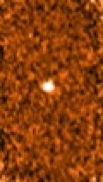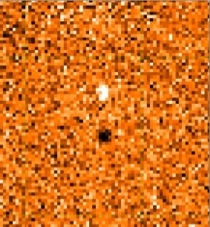
The Transneptunian objects (TNOs) and the Centaurs are small icy bodies in orbit around the Sun. They are at the far end of the solar system, beyond Neptune for the former and between Jupiter and Neptune for the latter. They constitute the most primitive known bodies in the solar system. They were unknown even two decades ago – detection techniques were at that time inadequate. Since their landmark discovery in 1992, over 1600 of these objects have been detected to date, and there a probably over 30 000 objects larger than 100 km. Their study should lead to a better understanding of the chemical composition of the primitive nebula, and the processes operating there during the early history of the solar system.
The characterization of the Transneptunian objects and the Centaurs constitutes a research axis of the Laboratoire d’Etudes Spatiales et d’Instrumentation en Astrophysique – LESIA (Observatoire de Paris/CNRS/UPMC-Université Pierre et Marie Curie/Université Paris Diderot). Consequently, the scientific department has involved itself in one of Hershel’s key programs [2] which is devoted to the observation of these objects using two instruments : the imaging photometers Photodetecting Array Camera and Spectrometer – PACS, the the Spectral and Photometric Imaging Receiver - SPIRE [3].
A paper to be published in the scientific Astronomy & Astrophysics journal contains novel data on the nine brightest objects observed during this program. They are members of different dynamic families. The sample includes in particular : the dwarf planet Haumea, two of the largest Transneptunians (Orcus et Quaoar), and the two largest known Centaurs (Chiron et Chariklo). The data obtained, of unequalled precision and in a new spectral domain, have led to a determination of these objects’ size, their reflectivity for solar light (albedo) and their thermal properties.
Quaoar, discovered in 2002, is a member of the classic Transneptunian population. It is accompanied by a small satellite, Weywot. Combining Herschel’s observations with those of NASA’s Spitzer telescope, has led to a more accurate determination of their sizes : Quaoar has a diameter of 1070±38 km and its satellite is much smaller, with a diamater of 81±11 km. This has led to a new value of the density, about 2,2 g/cm3 (comparable to that of Pluto), very different from the earlier much higher estimate of 4,2 g/cm3. This suggests the presence of abundant quantities of rocky material, although the surfaces are rich in water ice.
As far as Orcus is concerned, it is a « plutino » : the semi major axis of its solar orbit is the same as that of the dwarf planet Pluto. It also has a satellite, Vanth. Herschel’s data have enabled the size of Orcus to be found : 917±17 km, as well as that of Vanth, which is 276±17 km. The albedo is close to 23% and the density is 1,53±0,15 g/cm3. This latter value suggests a considerable abundance of water ice within Orcus.
In the case of the dwarf planet Haumea, its size has been confirmed to lie between 1180 and 1308 km, with a high albedo : 80 %.
A landmark result of this program is that these small bodies look « colder » the longer the wavelength used to observe them. This is interpreted as being due to the fact that these latter wavelengths originate from deep within the body, rather than from its surface. Material deep within the bodies receives less radiation than the surface and so is heated less. In this way, the Herschel telescope’s unique « eyes » have « penetrated » to regions which are inaccessible with classical observations using just visible light.
In a little over twenty years, the exploration and characterization of a vast population of icy objects in the outer regions of the solar system has become a major topic in planetology. Herschel has added its own bricks to the structure. It illuminates the subject with a new, cold, infrared light.
Reference
Paper by Sonia Fornasier, Emmanuel Lellouch, Thomas Mueller et coauteurs à paraître dans Astronomy & Astrophysics, sous le titre « TNOs are Cool : A survey of the Trans-neptunian region. VIII. Combined HERSCHEL PACS and SPIRE observations of 9 bright targets at 70-500 micron ».
Support
These studies were supported by CNES
Image

The dwarf planet Quaoar, at a wavelength of 250 micrometers, seen by Herschel. Its diameter is 1070±38 km, and its density about 2,2 g/cm3. Quaoar moves slowly in the sky ; two observations separated by one week were made, and the two were combined to make this composite (the second photograph was subtracted from the first : Quaoar can be seen both as a positive and as a negative image, a technique which enables one to correct for the background light around the object).
(ESA / SPIRE / Observatoire de Paris / LESIA)
[1] The Laboratoire d’Études Spatiales et d’Instrumentation en Astrophysique – LESIA is a department of the Observatoire de Paris. It is associated with the CNRS, àwith the Pierre and Marie Curie University - UPMC and with the Paris Diderot University.
[2] Entitled "TNOs are Cool : a survey of the Transneptunian region", this Hershel program has devoted 370 hours to the observation of a total of 130 objects.
[3] Each of the instruments PACS and SPIRE yielded flux measurements in the submillimeter range, in three wavelengths in the 70 - 500 micron band, for these cold celestial bodies, whose surface temperature is about 40 K (-233 C). All of these bodies were observed with PACS at 70, 100, and 160 microns, while only the brightest with SPIRE at longer wavelengths (250, 350, and 500 microns)
